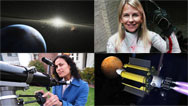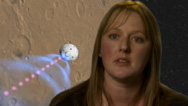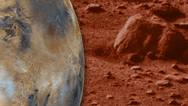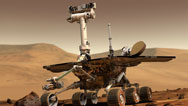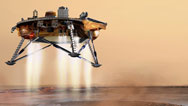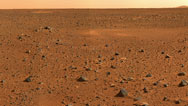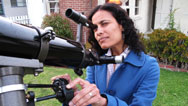
Ultimate Mars Challenge
In its search for life beyond Earth, NASA employs a "sky crane" maneuver to land the Curiosity rover on Mars. Airing November 14, 2012 at 9 pm on PBS Aired November 14, 2012 on PBS
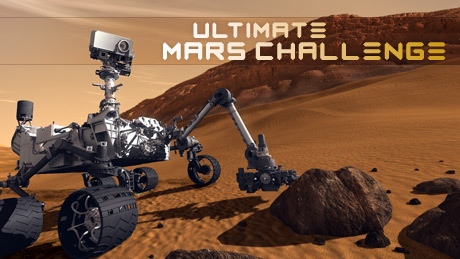
Program Description
Transcript
Ultimate Mars Challenge
PBS Airdate: November 14, 2012
VERONICA MCGREGOR (Jet Propulsion Laboratory Spokesperson): I want to present to you the team that has brought us back to Mars tonight.
NARRATOR: On August 5, 2012, this team made history. They built NASA's largest, most complex rover and landed it, safely, on the surface of Mars. Their success rests on a decade of exacting research and testing. They pushed the limits of technology, and their gamble paid off.
JIM MONTGOMERY (Landing Radar Field Test Lead, Mars Science Laboratory): That's awesome!
NARRATOR: Now, a rover, named Curiosity, is seeking clues to the questions we've asked for ages: Did life ever take hold on Mars? Could it exist there now?
JOHN GROTZINGER (Chief Scientist, Mars Science Laboratory): Are we alone? I think it's the grandest of all scientific questions.
MER SCIENTISTS: Look at this!
NARRATOR: We've explored Mars before. Previous missions revealed a planet more dynamic than we ever imagined. Curiosity will launch a new age of discovery, driven by an enduring dream.
ADAM STELTZNER (Entry Descent and Landing Lead, Mars Science Laboratory): We go exploring, because we are curious creatures, human beings.
JAIME WAYDO (Mobility Lead, Mars Science Laboratory): We want to discover the unknown. Going to Mars is like the new frontier.
ROB MANNING (Chief Engineer, Mars Science Laboratory): This will be the most exciting adventure we've ever undertaken on Mars.
NARRATOR: This rover was created to unlock the secrets of the Red Planet. Its mission is the Ultimate Mars Challenge, up next, on NOVA.
The moment of truth is fast approaching for several hundred engineers and scientists at the Jet Propulsion Laboratory, in southern California. Eight months ago, this team launched a mission to Mars. In less than an hour, the spacecraft they designed and built will touch down safely or meet an inglorious end.
The odds are against them; most missions to Mars have failed. Tonight, careers and reputations are on the line. The future of America's space program may hang in the balance.
What keeps drawing us back to the Red Planet? Mars may be only half the size of Earth, but it has grandeur: the largest known canyon in our solar system slices across its equator, roughly 10 times longer and three times deeper than the Grand Canyon on Earth; the tallest volcano in the solar system rises 16 miles above the Martian plain; colossal craters punctuate the planet—beautiful, but there's nothing welcoming about this place.
Mars lacks a global magnetic field to protect it from the solar wind. Blasted by radiation, its atmosphere, mostly carbon dioxide, is 100 times thinner than Earth's, too thin to trap much heat. Temperatures can rise above freezing at the equator during the Martian summer, but mostly the surface is frigid, averaging around minus-64 degrees Fahrenheit.
Liquid water would vaporize or freeze solid almost instantly on Mars today, and yet, water has left its mark all over the planet: river valleys, deltas, landscapes scoured by massive floods.
JOHN GROTZINGER: Most experts would agree that, three-and-a-half- to four billion years ago, on Mars, there was probably significantly more water, in lakes, as flowing rivers at times. To some extent, Mars is like a twin of Earth, early in its history.
NARRATOR: Back when Mars was awash with water, did life take hold there? What transformed the planet into a frozen wasteland? Could there be life on Mars today? These are the questions that lead us back to the Red Planet time and again.
NASA's latest mission is the Mars Science Laboratory, or M.S.L. Its crown jewel is a rover named Curiosity, the most complex robotic spacecraft ever destined for another planet.
ADAM STELTZNER: I love the fact that our rover is named Curiosity, because I think that's why she exists.
JAIME WAYDO: You hear us talk about her as if she's a person, because, to us, she is.
NARRATOR: Curiosity's a marvel of technology: packed with custom-made science instruments, wired for interplanetary communication, and powered by a nuclear battery, everything she needs to complete her two-year mission in the extremes of Mars.
JOHN GROTZINGER: The goal of this mission is to undertake the search for habitable environments. What it reduces to is the search for three very simple ingredients for life itself.
NARRATOR: On Earth, all living things rely on these three essentials: a source of energy, like the sun above or volcanic activity below; liquid water; and organic compounds, carbon-based molecules that are the building blocks of all life.
Has Mars ever had what it takes to support life? This rover is equipped to find out, by analyzing the rocks and soils of the Red Planet. Curiosity is as close as we can get to sending a field geologist, like John Grotzinger, to Mars.
JOHN GROTZINGER: When a geologist looks at a landscape like this, on Earth, we're looking for a way to unravel what the early environmental history of the planet was. Now, on Mars, with Curiosity, we can do the same thing.
NARRATOR: But Curiosity carries tools that Earth geologists would envy.
JOHN GROTZINGER: Every geologist has a hand lens to look at the grains that make up the rock. Curiosity has the equivalent, the MAHLI instrument.
NARRATOR: The Mars Hand Lens Imager, or MAHLI, can view rocks up close or from afar.
JOHN GROTZINGER: We can focus the lens to different distances, depending on what we're looking at. So it'll actually be better than this.
Photography is really important because it creates a context for all of the other measurements and observations. Curiosity has seventeen cameras. We've got telephoto capability, mid-range to near-field, and we can also capture video.
NARRATOR: To collect rock samples, a geologist uses a basic rock hammer.
JOHN GROTZINGER: We use it to get rock that is not exposed at the surface of the Earth, for doing the geochemical analysis that tells us about the origin of the rock.
NARRATOR: Curiosity has more advanced techniques for tackling rock, like a laser that can vaporize a spot the size of a pinhead up to 25 feet away. A flash of colored light is released, revealing the rock's chemical composition. The rover also has a drill that pulverizes rock and collects the resulting powder.
JOHN GROTZINGER: On Earth, we'd have to take the piece that we broke back to the lab, to do the analysis there. With Curiosity, we bring the lab to the field.
NARRATOR: The rover's robotic arm feeds powdered rock and soil to two miniaturized laboratories inside the rover. One lab uses x-ray beams to identify minerals, the other tests for the presence of organic molecules that may have been associated with life.
JOHN GROTZINGER: What's important about organic molecules is that you don't have to have an actual fossil of an organism left behind, in order to detect the former presence of life. So, we're not doing life detection, but we can look for these organic compounds.
NARRATOR: Curiosity's capabilities herald a new era of Mars exploration.
MICHAEL WATKINS (Mission Manager, Mars Science Laboratory): This is a mission that really advances our knowledge of Mars in a way that we just weren't capable of doing in the past. We're taking fifteen times more scientific equipment with us, this time. And, therefore, the rover that drives that around on Mars has to be that much bigger.
NARRATOR: Curiosity weighs nearly one ton, more than twice the combined weight of all previous Mars rovers. And, when it comes to landing on Mars, every pound matters.
ASHWIN VASAVADA (Deputy Project Scientist, Mars Science Laboratory): We knew we needed a new landing system. We'd never landed anything this big on Mars before.
NARRATOR: All the successful landings have used the same techniques, up to a point: the vehicle is packed in a back shell, with a heat shield to protect it from the friction of entering Mars' atmosphere; then a parachute takes over. But the Martian atmosphere is too thin to slow the descent all the way to a soft touchdown. So what are the options? Giant airbags allowed previous rovers to bounce to safe landings.
TOM RIVELLINI (Entry, Descent and Landing Mechanical System Lead): But, as it turns out, this rover was essentially too big to make airbags be the right solution. We looked at that, and the airbags wound up just being big and heavy. So we said, "Okay, let's come up with something else."
NARRATOR: A rocket-powered descent, on a lander with legs, was a more traditional approach.
ROB MANNING (Chief Engineer, Mars Science Laboratory): That's how you're supposed to do it. You're supposed to land with your rocket below you, climb down the ladder, and explore. That's how Buck Rogers did it; that's how the Apollo astronauts did it.
ADAM STELTZNER: But we could see a legged lander system would be too top-heavy, with a big rover sitting on top of it.
ROB MANNING: So we said to ourselves, "Why don't we turn it upside-down? Let's flip it around, and put the rocket on the roof and land the rover on its wheels below."
TOM RIVELLINI: We just started burrowing in on this idea of this rocket-powered jetpack with the rover dangling below it.
BOBAK FERDOWSI (Mission Planner, Mars Science Laboratory): Looking at it, it's not intuitive. I think we affectionately called it "hope on a rope," at one point.
NARRATOR: They added a new twist to the old landing systems. It goes like this: Curiosity hits Mars' atmosphere at 13,000 miles per hour; friction slows the spacecraft to 900 miles per hour, then the parachute is deployed; a mile above the surface, the descent stage drops away and fires up its rockets; then, something called "the sky crane maneuver" begins. The descent stage lowers the rover on cables; upon touchdown, the cables are cut, and the descent stage flies off to crash at a safe distance. The entire sequence takes just seven minutes and requires perfect precision.
TOM RIVELLINI: Literally, millions of little things have to go just right, like a chain, for success at the bottom of the chain, or it's just game over.
NARRATOR: To show off their brave new landing system, the engineers created a short video presentation. It was not a runaway hit.
ASHWIN VASAVADA: Some of our NASA bosses, they just were in horror after seeing this video.
JOHN GROTZINGER: It's the kind of thing that you wonder if they're going to be taking odds on it in Vegas.
BRANDON METZ (Robotic Systems Engineer, Mars Science Laboratory): The landing sequence, it's just, like, surreal of, like, "Really? We're going to do that?"
TOM RIVELLINI: Probably the biggest challenge in the sky crane system was credibility, trying to convince people that the sky crane system was not an insane contraption, but was actually a very elegant piece of machinery.
NARRATOR: To prove their design, they had to test it, but that became its own challenge.
ADAM STELTZNER: Here on Earth, you cannot test one large simulation that takes us from above the atmosphere down to the surface of Mars, not the right atmosphere, not the right gravity.
ROB MANNING: So, we have to break the testing down in lots of little pieces, and, by looking at these little individual parts of our testing, convince ourselves the whole will work.
NARRATOR: Piece by piece, team by team, testing this new landing system would take years.
Curiosity's parachute would be the largest ever flown on another world: 51 feet in diameter, capable of withstanding 65,000 pounds of force. To test it, a team set out for the largest wind tunnel in the world, at NASA Ames Research Center.
ADAM STELTZNER: We felt confident that the parachute was designed correctly and that these tests would go smoothly.
NARRATOR: Their first test was a winner.
DOUGLAS ADAMS (Parachute Cognizant Engineer, Mars Science Laboratory): The parachute opens, the building shakes, and you see this thing flying in the air, and the data, and everybody's excited, and it's tremendous.
NARRATOR: They moved on to test number two.
TECHNICIAN: Three, two, one, fire!
Bad chute!
DOUGLAS ADAMS: Catastrophic failure. It blew up…little pieces of parachute all over, and it just…a bag of rags at the end of the tunnel. The parachute is…it's a loss.
It's almost like you lost a friend or something, you know? Fallen comrade in the wind tunnel. And it caught us by surprise. We didn't expect that.
NARRATOR: The team was devastated.
TOM RIVELLINI: That basically kicked off a forensic test program to figure out why that parachute exploded so catastrophically, and was this a threat to the Mars mission?
NARRATOR: All they had was a grainy video of the failure. They needed better data.
ADAM STELTZNER: So we went out and we got 13, I believe, maybe 14 cameras: high resolution, high-speed video, all sorts of different angles.
DOUGLAS ADAMS: You know, if this thing happened again, if something bad happened again, we were going to catch it, this time.
NARRATOR: They resumed testing, hoping for the worst.
TOM RIVELLINI: We ran the first test. The parachute opened up, just as you would want it to, and we were disappointed.
ADAM STELTZNER: And we test again, good chute again; good chute again; and again. And we're like, "Well, jeez, if we don't see this problem again, it's going to be even worse!" It'd be better to capture it in high resolution, so we can understand what was going on, rather than just have this one-off occurrence.
NARRATOR: Failure did not come easily. It took six more tries.
TOM RIVELLINI: We were all really happy, all of a sudden. The parachute had exploded, but we were even happier, because all of the camera footage that we had put in place caught the smoking gun.
NARRATOR: What they had captured was an inversion. It occurs when the edge of one side of the parachute slips through the lines on the opposite side. A pocket of fabric catches air and inflates, pulling the parachute inside out and tearing it apart.
Could an inversion happen on Mars? The team had to find out.
DOUGLAS ADAMS: Looks like we have just as high a risk of an inversion.
NARRATOR: They studied the videos for months.
DOUGLAS ADAMS: This is much less organized than it is here.
NARRATOR: And then it dawned on them. In the wind tunnel, the parachute took much longer to inflate than it would in the Martian atmosphere.
TOM RIVELLINI: On Mars, when you pop out your parachute, a second later, it's open. In the wind tunnel, it takes six seconds, seven seconds, eight seconds.
ADAM STELZTNER: And so, waiting to fill up this bag of air, the flapping of the parachute can allow bits of it to overlap and then be pulled through and invert.
NARRATOR: And the risk of an inversion was even greater because of another test condition.
DOUGLAS ADAMS: We were deploying the parachute sideways, so gravity is pulling the parachute down. That causes the top of the parachute to fall through the bottom of the parachute.
NARRATOR: This won't occur on Mars, where the parachute will deploy upward.
TOM RIVELLINI: It took a long time to actually figure out that this was an Earth test problem and not a Mars problem. It was a real nail-biter. Since we've only got one parachute, you, kind of, got to get it right.
NARRATOR: The team was confident that, on Mars, their parachute would perform according to plan.
Shortly after the parachute opens and the heat shield drops away, the radar system begins to play a critical role. By bouncing radio waves off the surface of Mars, the radar measures Curiosity's altitude and speed. Those measurements tell Curiosity when it's time to begin the powered descent, and then the sky crane maneuver. Perfect timing is key to a perfect touchdown.
Curiosity's cutting-edge radar is composed of six high-power, narrow-beam antennas mounted to the descent stage. Each antenna takes 20 measurements per second, for unprecedented range and accuracy…at least in theory.
STEVEN LEE (Control Systems Manager, Mars Science Laboratory): We had to be able to test the radar under all the conditions that it could be exposed to at Mars. And that is a very wide range of altitudes.
NARRATOR: The radar kicks in about five miles above the surface of Mars, while falling nearly three hundred miles per hour. So Steven Lee and his team took their system to NASA's Dryden Flight Research Center. They mounted a radar antenna below the wing of an F/A-18 supersonic jet, for a series of daredevil flights.
The pilot would climb to 50,000 feet, slow down, roll over and fall from the sky. During those five- to eight-second drops, the radar sent measurements of altitude and speed. The numbers were spot on.
The team mounted the radar to the nose of a helicopter for tests at lower altitudes, over the Mars-like terrain of the Mojave Desert.
JIM MONTGOMERY: We flew over lava flows. We flew over sand dunes.
STEVEN LEE: We flew around a crater that has a lot of shapes that are very similar to what we will see on Mars.
NARRATOR: But the sky crane maneuver posed a problem for the radar. As the rover is lowered to the ground, it can interfere with some of the beams, which would confuse the radar.
The engineers decided to shut down four beams and angle two beams away from the rover. But would that provide enough data for a safe touchdown? They devised an elaborate test.
ADAM STELTZNER: Underneath the helicopter, we had a radar mockup of the rover that we would lower and raise, so that we could look at how the radar might bounce off the rover and spoof and confuse the radar.
Now he's bringing it down!
If we get through that test, and the radar isn't spoofed by a model of the rover jumping out in front of it, we're really good for Mars.
STEVEN LEE: We found that two beams, even if they're angled up and away from where the rover is going to be, were enough to tell us how fast we were moving towards the ground.
NARRATOR: The radar's job will be over once Curiosity makes contact with the ground. But what will protect the rover from the impact of touchdown?
Jaime Waydo led the team that designed and built Curiosity's mobility system, the six wheels, suspension and other mechanisms that allow the rover to roll over terrain. This system also had to function as Curiosity's landing gear.
JAIME WAYDO: The rover touches down at almost three feet a second, which doesn't sound that fast, but some of those loads are 2,500 pounds, going into each individual wheel. And what the wheels don't absorb goes into the suspension. We're just trying to make sure that all of those precious science instruments are safe.
NARRATOR: They needed a way to make the system as strong, yet as light as possible. Inspiration rolled in on two wheels.
JAIME WAYDO: If you look at the modern bicycle, they do amazing things with shaping the tubes of the bicycle frame, for the stiffnesses they want, in every direction. And so, we talked to a bicycle company that makes titanium bikes, and they helped us build the suspension tubes.
NARRATOR: Curiosity's wheels were redesigned as well.
JAIME WAYDO: We ended up taking a bicycle wheel and making it as strong as possible and taking that to the extreme and making it, basically, a Martian bicycle wheel.
NARRATOR: Curving titanium spokes and a pliable aluminum skin would make the wheels tough but resilient.
Waydo and her team would test their new system in stages.
JAIME WAYDO: We're going to do our final countdown and then we'll test.
NARRATOR: They used a model rover, without its wheels, to check the mechanisms that release the mobility system during the sky crane maneuver. The rover has just six seconds to pop its wheels into place for touchdown.
JAIME WAYDO: That test was really focused on making sure that, as mobility is deploying, there's nothing that's going to hang up, that all of the cables can move smoothly and they're not going to catch on each other.
NARRATOR: Small pyrotechnics would release the latches that hold the system close to the rover's body.
ADAM STELTZNER: I don't think any of us really thought it would be as violent, as noisy or as herkedy-jerkedy of an event. From amongst a human perspective, there was a lot of, "Oh, my god, is that, is that right?"
JAIME WAYDO: It's not graceful. But it's what you do to get 200 pounds of hardware to go 60 degrees in six seconds and be ready for landing.
NARRATOR: Waydo's team used a stripped-down rover model to measure the stresses of touchdown.
This simulation was also a test of Waydo's nerves.
JAIME WAYDO: My hands are sweating, and my throat is getting dry, and I'm looking at it going, "Oh, my goodness. Oh, my goodness." And then, they let it go, and she hit, and it was so hard. And I was like, "You can't do that to our baby! That's too much! That's too hard!"
ADAM STELTZNER: It's like that old Vaudeville joke, right? It's not the fall that kills you, it's the landing, right?
JAIME WAYDO: That's extremely brutal. And then, you realize, "No, we designed her for that. She's good for that. It's okay." But that tangible, visceral, "What does landing look like?" is much different on a computer simulation than, than the first time you see it for real.
TOM RIVELLINI: Congratulations, Jaime.
ROB MANNING: The great thing about landing on your wheels is that you're ready, you've landed! Now, you can drive around the surface of Mars and go do great science and do some exploration.
NARRATOR: To prove Curiosity's driving abilities, test rovers racked up mileage over all kinds of terrain.
SAVANNAH MCCOY: Brakes engaged; motion complete.
NARRATOR: Sand dunes had been a problem for previous Mars rovers,…
JOHN GROTZINGER: Still making progress.
NARRATOR: …but Curiosity's wide wheels seem unsinkable.
JOHN GROTZINGER: Let's get it really stuck.
ADAM STELTZNER: Okay.
JOHN GROTZINGER: This is good, Adam. This is what I was hoping for.
ADAM STELTZNER: What I'm learning is that it's really hard to get this thing stuck.
STEVEN LEE: That's why we're here!
NARRATOR: With each test, Mars seems closer than ever.
We've been exploring Mars for half a century, but dreaming about it for ages.
NARRATION: Life forms on Mars may have developed special ways of preserving their water content.
NARRATOR: We once imagined it might harbor strange flora and fauna, even intelligent life.
NARRATION: Are they planning an invasion?
NARRATOR: Then, in the 1960s, space probes began to transmit the first close-up images of the surface: no cities; no oceans or forests. If there was life on Mars, it was microscopic.
In 1976, NASA achieved its first landings on Mars. Two Viking spacecraft, on opposite sides of the planet, tested the soil for living organisms. They found no conclusive signs of life and not a single organic compound. Mars was declared dead.
ASHWIN VASAVADA: Then we, kind of, because of that disappointment, took a break from exploring Mars, for over a decade.
NARRATOR: When we returned to Mars, we pursued a different line of reasoning: if Mars ever had life as we know it, it would have needed liquid water. Those channels and valleys looked like they'd been carved by water, but what if some other force, like lava flows had created them?
NASA's exploration strategy became "follow the water." A new generation of orbiters began to scour the Martian surface.
PHIL CHRISTENSEN (Arizona State University): The beauty of orbit is you can send a lot of instruments. These orbiters are pretty big. We've flown cameras that can actually measure the temperature of the surface, lasers that can measure the height of the mountains, and spectrometers that can map what minerals are present. So, from orbit, we can map the entire planet and figure out where all the goodies are.
NARRATOR: One satellite pinpointed an area rich in hematite, a mineral that forms in water.
PHIL CHRISTENSEN: If I was going to try to find where to land on Mars and look for water, this place is screaming, you know, "Come here!"
NARRATOR: A rover named Opportunity was sent to investigate. Scores of tiny spheres were scattered on the ground and embedded in layered rock.
STEVE SQUYRES (Cornell University): The fact that these rocks are layered says that one possible origin for these is that they were laid down in liquid water. And we have, on our rover, a toolkit of gizmos that will tell us that answer.
NARRATOR: Opportunity determined these were spheres of hematite that had formed, like pearls in oysters, when the rock was saturated with salty water.
STEVE SQUYRES: We think we're parked on what was once the shore of a salty sea on Mars. That's pretty cool.
NARRATOR: Finally, proof of liquid water, discovered on Mars.
On the opposite side of the planet, Opportunity's twin, a rover named Spirit, explored a site thought to be an ancient lake. Spirit uncovered soil so rich in bright white silica, that water and intense heat must have been involved in its creation. It seems ancient Mars may have bubbled with hot springs.
The strategy of "follow the water" also revealed the presence of water on Mars today. An orbiter detected vast amounts of hydrogen, depicted in blue, just beneath the planet's surface. Hydrogen is often a sign of H2O, water. Could all this blue be ice?
A lander, named Phoenix, tested the idea in the north polar region. It dug a shallow trench and exposed mysterious white clumps.
PETER SMITH: We found some bluish ice-like material that has the science team arguing incessantly about whether it's ice or salt or some other exotic material.
SCIENTIST: That is ice!
NARRATOR: In days, the clumps vaporized. It was water ice. Mars has enough near-surface water ice that, melted, it would cover the planet in a sea, at least 30 feet deep.
There are even hints that liquid water may appear, fleetingly, on Mars today. In the southern hemisphere, in spring, dark streaks appear in steep gullies and extend downhill, then fade away in the fall. Some scientists believe the streaks may be caused by salty water flowing just beneath the surface.
PHIL CHRISTENSEN: This big picture orbital view really has just revolutionized how we think about Mars. There are incredible mineral deposits, rocks that formed in lakes and hot springs. We even think there might be water that's flowing in little channels today.
NARRATOR: And recently, orbiters and Earth-based telescopes detected something surprising in the Martian atmosphere: trace amounts of methane gas.
On Earth, methane can be produced by geologic activity, but most is generated by microorganisms, as a waste product. Today, Mars has no active volcanoes and no apparent life on its surface, so what could be the source of its methane? Geologic activity deep within the planet? Subterranean Martian microbes? For now, that remains a mystery, one of many that Mars still holds close. But this much we do know: Mars has had two of the ingredients for life: the energy of the sun and liquid water.
Now Curiosity stands poised to discover the third ingredient: organic molecules, but only if the rover manages to sample Martian rocks and soil. And that depends on the strength and precision of Curiosity's robotic arm.
BRANDON METZ: The robotic arm is extremely complex, because we have five joints. We have what we call the azimuth joint, which is really just kind of…you can think of your shoulder moving back and forth. Then we have elevation, which, again, is like your shoulder moving up and down. And then we have the elbow, which actually works like the elbow; it usually moves like that. And then we have wrist, which is just, kind of, like the wrist: it moves it about here. And then we have turret, which allows us to, like, rotate 360, you know, in either direction. So, so the robotic arm it is really an engineering masterpiece.
NARRATOR: The arm supports a turret of instruments that collect, process and deliver samples to the rover's onboard laboratories. Curiosity will not be the first spacecraft to scoop up Martian soil, but drilling on Mars will be historic.
DANIEL LIMONADI (Surface Sampling Lead, Mars Science Laboratory): We haven't drilled on another planetary body since Apollo.
APOLLO ASTRONAUT: Okay, Bob. I've got my tools of the trade, right here.
DANIEL LIMONADI: Their drills were more challenging in that they needed to get, like, one-meter to two-meter cores, but they had astronauts that could react to the situation. Once you penetrate the surface of another planet, now you have to deal with all kinds of unknowns…
MICHAEL WATKINS: …how to keep the drill perfectly clean; how to isolate it from the mechanical workings of the motors; how to not drill into a rock that will end up clogging the system, so that we can't use it anymore. These are really the big challenges.
NARRATOR: Engineers tested several drill designs before settling on an exceptionally sturdy model.
DANIEL LIMONADI: It's a rotary percussive drill. And that's typically what you would buy to go, to like drill through concrete in your yard or whatever. The main difference is the average person, in their yard, doesn't want to collect the powder. So we have a powder collection system, effectively, around the drill bit.
NARRATOR: The drill's rotation carries the powdered rock up inside the turret, where it's passed through a sieve to filter out larger particles. To keep the sample flowing through the system requires a whole lot of shaking.
DANIEL LIMONADI: Most spacecraft, you try to keep pristinely clean, and then you try not to bang them up more than they have to. We, on purpose, shake the turret really hard, and we know we're going to get dirt everywhere. We have to get used to more violent hardware. It's more like a mining operation a fine precision operation.
MICHAEL WATKINS: Actually, to understand how to build that drill system that doesn't shake the arm apart or shake the rover computer too much was a big challenge.
NARRATOR: But the scariest thing about drilling on Mars is not the vibration or the dust. Curiosity is likely to drill on uneven or steep terrain. If the rover slips, it could yank on the arm and damage it. If the drill gets stuck in the rock, it could anchor the rover in place. But there's a backup plan.
DANIEL LIMONADI: If, heaven forbid, the bit would get stuck, we actually have two spare drill bits. We would un-chuck the bit, leave it there, and then we would grab another one to live another day.
ENGINEER: Three, two, one, go.
NARRATOR: After years of piecemeal testing, a milestone draws a crowd: the first end-to-end sampling test, from drilling to sifting powdered rock to delivering a sample, the equivalent of dropping an aspirin in a thimble.
DANIEL LIMONADI: One of the kind of comedies of scale of this rover, is we have, you know, a 900 kilo rover with a100 kilo arm, and we drop off a little, tiny, you know, sample to each instrument. And that's enough for them to do their science.
NARRATOR: A pinch of powdered rock may tell us whether Mars ever harbored the building blocks of life.
So where should Curiosity touch down to gather that powdered rock? Previous missions needed a vast expanse of smooth, flat terrain for landing. Those spacecraft were aimed at specific sites on Mars, but unpredictable atmospheric conditions, like the density of the atmosphere or the amount of wind, could shift the point of touchdown by miles.
ADAM STELTZNER: We don't know what the atmosphere's going to be like on the day that we land. That spreads out that uncertainty and means it's really hard to find a safe place that's over that huge amount of land.
NARRATOR: But Curiosity can achieve a precision landing, through a technique called guided entry. Just before entering Mars' atmosphere, the spacecraft jettisons two weights. This shifts its center of mass and generates lift, like the lift beneath an airplane wing. Now the spacecraft can fly.
It monitors the atmosphere and fires thrusters to move higher or lower, to bank left or right, adjustments that help it stay on target.
ADAM STELTZNER: And that allowed us to shrink our landing uncertainty, our footprint of where we might end up on the surface, from something more than 100 kilometers to something down around 20 kilometers or maybe even a little less. And that opens up a ton of places to land.
NARRATOR: There were so many possible landing sites for Curiosity, it took more than a hundred experts five years to pick one.
MATT GOLUMBEK: …the breaching of the rim and the creation of what was proposed to be a lake, inside Holden.
NARRATOR: Dozens of sites were analyzed in detail, but all had one thing in common.
SCIENTIST: If you go up through the sequence, there are some incised channels.
PHIL CHRISTENSEN: The starting point was, "Are there interesting minerals there that we think formed in water?" If a site didn't have that, it really wasn't in the running.
NARRATOR: The experts voted, and, finally, a winner was announced: …
ASHWIN VASAVADA: The votes are in!
NARRATOR: …Gale Crater. Nearly a hundred miles across, this ancient impact crater may once have been flooded with water. Today, a mountain of layered rock, named Mount Sharp, rises three miles above the crater floor. Orbiters detected minerals that form in water in the lower layers of the mountain. Upper layers may preserve a record of millions of years of Martian history.
PHIL CHRISTENSEN: And you know, geologists, their eyes light up when they see layered rocks, because that's the storybook.
JOHN GROTZINGER: Exploring Mount Sharp, we start at the bottom, and we go to the top. We drive up through the layers, and we turn through the pages and chapters, and we may not finish the book, but I'm sure it's going to be a good read.
NARRATOR: By the summer of 2011, hardware for the mission has been built and tested. Now, there's a deadline that cannot be missed. Mars takes nearly two years to orbit the Sun. Its distance from Earth changes constantly. The ideal alignment for a Mars launch occurs every 26 months, and that moment is fast approaching.
ROB MANNING: I have had a tradition of pulling out my trumpet as our spacecraft have left J.P.L. The day that it's put in a box and shipped across the country to Florida is the day it's really leaving to Mars.
NARRATOR: The engineers who built Curiosity take her as far as Kennedy Space Center and say goodbye. Then a new team assembles the rover and all her flight components into a spacecraft. The process takes five months and ends at the top of an Atlas V rocket.
On November 26, 2011, it's all systems go.
NASA ANNOUNCER: T minus 10, 9, 8, 7, 6, 5, 4, 3, 2, 1. Lift off of the Atlas Five with Curiosity.
Next stop: Mars.
As the sun begins to set over the Jet Propulsion Laboratory, anticipation is rising.
NEWSCASTER: …finding out whether life ever existed on Mars.
NARRATOR: The real Curiosity is 150-million miles away, just hours from the end of her journey. For the members of the mission team it's a night of mixed emotions.
JIM MONTGOMERY: I just can't even tell you how excited I am. I just want to remember every single moment.
STEVEN LEE: …mostly confident, but there's still that little knot of fear in there.
TOM RIVELLINI: Spend 10 years of your life working on one project, and it either works or doesn't. There's really no in-between.
ADAM STELTZNER: In a few hours, hopefully, there's a new rover on the surface of Mars. It's kind of an emotional time, as you can see. We're wishing for the best. We feel that we've done everything to deserve it, and now it's in the hands of the fates.
NARRATOR: Engineers can still communicate with Curiosity, but during the seven-minute landing sequence, the rover will operate autonomously, based on pre-programmed commands. That's because it takes 14 minutes for signals to travel between the Earth and the rover.
BOBAK FERDOWSI: We can't joystick it from Earth. So when we're sitting there, it's like a time machine. You're just, like, looking back at the past, and you're like, "Okay," you know, "14 minutes ago, this worked," and "14 minutes ago, that worked." And so, it's a very surreal feeling, knowing that it's all been finished, but that you still don't know what happened.
NARRATOR: In moments, Curiosity will hit Mars' atmosphere. Seven minutes later, one way or another, the rover will be on the surface of Mars.
ALAN CHEN: Coming up on entry.
NARRATOR: What the team calls "seven minutes of terror" begins now.
MISSION CONTROL VOICES: Coming up on entry.
Start of guided entry.
Vehicle's continuing to decelerate, down to Mach 2.
Parachute deploy.
We are decelerating.
Heat shield has separated.
We're down to 90 meters per second, at an altitude of 6.5 kilometers, descending.
We are in powered flight.
Standing by for sky crane.
Sky crane has started.
Descending at about point-75 meters per second, as expected.
Tango Delta nominal.
R.I.M.U. stable.
R.I.M.U. stable.
U.H.F. is good.
Touchdown confirmed.
We're safe on Mars!
NARRATOR: Suddenly, they start receiving postcards from Curiosity.
ENGINEER: It's the wheel!
NARRATOR: The equivalent of: "Hello. I'm fine. Wish you were here." And, in a way, the team is there, basking in the sunshine of a Martian afternoon.
From the start, Curiosity has dazzled the mission team with vistas of Gale Crater. Two weeks after landing, she sent snapshots from her first drive, but mission scientists were intrigued by photos of scour marks created by the blast of the landing rockets.
JOHN GROTZINGER: The thrust was so forceful, it blew the soil and the pebbles away, which gave us an opening to the bedrock. We saw that it was composed of fragments of different kinds of material. So, the team began to wonder, gosh, maybe it was kind of a cemented material that had to do with water.
NARRATOR: It was an exciting clue, because the exact nature of the terrain where Curiosity touched down was not known.
Orbital maps suggested water had flowed through a canyon in the northern rim of the crater, carrying rocks and sediments that spread out on the crater floor in what's called an "alluvial fan." But did that fan extend all the way to where Curiosity landed?
Five weeks into the mission, the rover sent back pictures of an outcrop that stunned the science team.
JOHN GROTZINGER: You're like, "My goodness, it looks like somebody got a jackhammer up and lifted up a piece of the sidewalk in New York City." And when you look at the slab, end on, you see pebbles in it. They seem to have rounded edges; they've all been smoothed off a little bit. And so, what that brings to mind immediately is what you see in a, in a riverbed. As the water pushes the pebbles along, they collide with each other, and they progressively get rounder.
NARRATOR: Previous rovers detected shallow seas and hot springs. This is something new.
JOHN GROTZINGER: The team converged pretty much unanimously on this being an ancient pebble deposit, formed in a river that had once been present in this part of Mars, billions of years ago.
NARRATOR: From the size of the pebbles, scientists believe the river flowed vigorously and might have been hip-deep.
JOHN GROTZINGER: This is the first place where we have evidence for water flowing across the surface, and that's something we've never been able to discover before on Mars.
NARRATOR: As Curiosity drives on, she samples Martian soil and discovers minerals similar to those in volcanic soils in Hawaii. In her first sniffs of the atmosphere at Gale Crater, her sensors detect carbon dioxide but no methane. Perhaps methane on Mars is more transient than expected. More tests may tell.
But Curiosity's ultimate destination, perhaps a year's drive away, remains Mount Sharp, with its foothills of ancient layered rock.
JOHN GROTZINGER: When you see those foothills, it looks like a familiar place. It's like you'd almost come home, in a way, to a different part of the Earth, except this is Mars.
ASHWIN VASAVADA: You may as well be in the Mojave Desert or someplace in Utah. It just begs the question, "Why shouldn't Mars have life, just like Earth?" And really, that's why we're here; that's the question we're trying to answer.
NARRATOR: We have followed our curiosity to another world. Who knows where it will lead? Our journey of discovery has just begun.
Broadcast Credits
- WRITTEN and DIRECTED BY
- Gail Willumsen
- PRODUCED BY
- Jill Shinefield
Gail Willumsen - EDITED BY
- John Wolfenden
Leonard Feinstein - CAMERA
- John Beck
Peter Bonilla
Kris Denton - SOUND RECORDISTS
- Ken King
Marla Hettinger
J.E. Jack - NARRATED BY
- Lance Lewman
- MUSIC
- Gil Talmi
Andrew Gross - JPL MSL Animation
- Kevin Lane
- ANIMATION
- Pixeldust Studios, LLC
- ONLINE EDITOR AND COLORIST
- Mark Needham
- ADDITIONAL GRAPHICS
- Christian McIntire
- AUDIO MIX
- Matt Slivinksi
- ADDITIONAL MUSIC
- konsonant/
- MUSIC EDITOR
- Lily Virginia
- ASSISTANT CAMERA
- Jean-Pierre Caner
- PRODUCTION ASSISTANT
- Dean Jacobson
- SCIENCE ADVISOR
- Jim Bell
MSL Design Plans Courtesy NASA/JPL-Caltech
- ARCHIVAL MATERIAL
- Corbis Images
ESA
ESA/DLR/FU Berlin (G. Neukum)
Getty Images
Hannah Goldberg
Doug Holgate
Indiana State Museum and Historic Sites
------
Adrian Lark
MOLA Science Team
NASA
NASA Dryden Flight Research Center
NASA/Goddard Space Flight Center
NASA/Goddard Space Flight Center Scientific Visualization Studio
NASA/NSSDC
NASA/JPL-Caltech
NASA/JPL-Caltech/Arizona State University
NASA/JPL-Caltech/Arizona State University, R. Luk
NASA/JPL-Caltech/Arizona State University/Selden Ball
NASA/JPL-Caltech/Cornell
NASA/JPL-Caltech/Cornell/ Arizona State University
NASA/JPL-Caltech/Cornell/US Geological Survey
NASA/JPL-Caltech/Ken Kremer/Marco Di Lorenzo
NASA/JPL-Caltech/Malin Space Science Systems
-------
NASA/JPL-Caltech/University of Arizona
NASA/JPL-Caltech/University of Arizona/Texas A&M University
Nash Films LLC
Kees Veenenbos - SPECIAL THANKS
- Stephen Kulczycki
Veronica McGregor
Guy Webster
Mark Petrovich
-------
Elena Mejia
Bert Ulrich
Robert Burnham
American Bicycle Group
U.S. Dept. of the Interior, BLM, Barstow Field Office
Inland Empire Film Commission - NOVA SERIES GRAPHICS
- yU + co.
- NOVA THEME MUSIC
- Walter Werzowa
John Luker
Musikvergnuegen, Inc. - ADDITIONAL NOVA THEME MUSIC
- Ray Loring
Rob Morsberger - POST PRODUCTION ONLINE EDITOR
- Spencer Gentry
- CLOSED CAPTIONING
- The Caption Center
- MARKETING AND PUBLICITY
- Karen Laverty
- PUBLICITY
- Eileen Campion
Victoria Louie - SENIOR RESEARCHER
- Kate Becker
- NOVA ADMINISTRATOR
- Kristen Sommerhalter
- PRODUCTION COORDINATOR
- Linda Callahan
- PARALEGAL
- Sarah Erlandson
- TALENT RELATIONS
- Scott Kardel, Esq.
Janice Flood - LEGAL COUNSEL
- Susan Rosen
- DIRECTOR OF EDUCATION
- Rachel Connolly
- DIGITAL PROJECTS MANAGER
- Kristine Allington
- DIRECTOR OF NEW MEDIA
- Lauren Aguirre
- POST PRODUCTION ASSISTANT
- Brittany Flynn
- POST PRODUCTION EDITOR
- Rebecca Nieto
- POST PRODUCTION MANAGER
- Nathan Gunner
- COMPLIANCE MANAGER
- Linzy Emery
- BUSINESS MANAGER
- Elizabeth Benjes
- DEVELOPMENT PRODUCER
- David Condon
- PROJECT DIRECTOR
- Pamela Rosenstein
- COORDINATING PRODUCER
- Laurie Cahalane
- SENIOR SCIENCE EDITOR
- Evan Hadingham
- SENIOR PRODUCERS
- Julia Cort
Chris Schmidt - SENIOR SERIES PRODUCER
- Melanie Wallace
- MANAGING DIRECTOR
- Alan Ritsko
- SENIOR EXECUTIVE PRODUCER
- Paula S. Apsell
A NOVA Production by Gemini Productions LLC in association with ARTE France
© 2012 WGBH Educational Foundation
All rights reserved
Image
- (Mars Curiosity)
- Courtesy NASA/JPL-Caltech
Participants
- Douglas Adams
- Parachute Cognizant Engineer, MSL
- Phil Christensen
- Arizona State University
- Bobak Ferdowski
- Mission Planner, MSL
- John Grotzinger
- Chief Scientist, MSL
- Steven W. Lee
- Control Systems Manager, MSL
- Daniel Limonadi
- Surface Sampling Lead, MSL
- Rob Manning
- Chief Engineer, MSL
- Brandon Metz
- Robotic Systems Engineer, MSL
- Jim Montgomery
- Landing Radar Field Test Lead, MSL
- Tom Rivellini
- EDL Mechanical System Lead, MSL
- Peter Smith
- University of Arizona phoenix.lpl.arizona.edu/smithPeter.php
- Steve Squyres
- Cornell University
- Adam Steltzner
- Entry Descent & Landing Lead, MSL
- Ashwin Vasavada
- Deputy Project Scientist, MSL
- Michael Watkins
- Mission Manager, MSL
- Jaime Waydo
- Mobility Lead, MSL
Preview | 00:30
Full Program
Full program available for streaming through
Watch Online
Full program available
Soon

